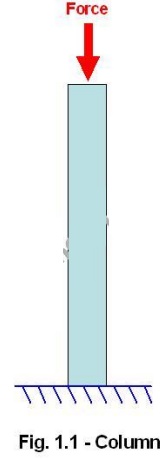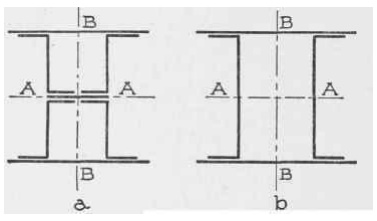Chapter: Mechanical : Strength of Materials : Deflection of Beams
Moment area method
Moment area method
Theorems of Area-Moment Method
Theorem I
The change in slope between the tangents drawn to the elastic curve at any two points A and B is equal to the product of 1/EI multiplied by the area of the moment diagram between these two points.
Theorem II
The deviation of any point B relative to the tangent drawn to the elastic curve at any other point A, in a direction perpendicular to the original position of the beam, is equal to the product of 1/EI multiplied by the moment of an area about B of that part of the moment diagram between points A and B.
Rules of Sign
1. The deviation at any point is positive if the point lies above the tangent, negative if the point is below the tangent.
2. Measured from left tangent, if ? is counterclockwise, the change of slope is positive, negative if ? is clockwise.
Columns –End conditions
Columns -end conditions
What is a Column or Strut?
Any machine member, subjected to the axial compressive loading is called a strut and the vertical strut is called column

The columns are generally categorized in two types: short columns and long columns. The one with length less than eight times the diameter (or approximate diameter) is called short column and the one with length more than thirty times the diameter (or approximate diameter) is called long column.
Ideally, the columns should fail by crushing or compressive stress and it normally happens for the short columns, however, the long columns, most of the times, failure occurs by buckling.
Euler’s Buckling Formula
To get the correct results, this formula should only be applied for the long columns. The buckling load calculated by the Euler formula is given by:
Fbe = (C*?2*E*I)/
Equivalent length of a column
Strength Of Columns
A stick of timber, a bar of iron, etc., when used to sustain end loads which act lengthwise of the pieces, are called columns, posts, or struts if they are so long that they would bend before breaking. When they are so short that they would not bend before breaking, they are called short blocks, and their compressive strengths are computed by means of equation 1. The strengths of columns cannot, however, be so simply determined, and we now proceed to explain the method of computing them.
77. End Conditions. The strength of a column depends in part on the way in which its ends bear, or are joined to other parts of a structure, that is, on its " end conditions." There are practically but three kinds of end conditions, namely:
1. "Hinge" or "pin" ends,
2. " Flat" or " square " ends, and
3. "Fixed" ends.
(1) When a column is fastened to its support at one end by means of a pin about which the column could rotate if the other end were free, it is said to be "hinged" or "pinned" at the former end. Bridge posts or columns are often hinged at the ends.
(2) A column either end of which is flat and perpendicular to its axis and bears on other parts of the structure at that surface, is said to be "flat" or " square" at that end.
(3) Columns are sometimes riveted near their ends directly to other parts of the structure and do not bear directly on their ends; such are called " fixed ended." A column which bears on its flat ends is often fastened near the ends to other parts of the structure, and such an end is also said to be " fixed." The fixing of an end of a column stiffens and therefore strengthens it more or less, but the strength of a column with fixed ends is computed as though its ends were flat. Accordingly we have, so far as strength is concerned, the following classes of columns:
78. Classes of Columns. (1) Both ends hinged or pinned; (2) one end hinged and one flat; (3) both ends flat.
Other things being the same, columns of these three classes are unequal in strength. Columns of the first class are the weakest, and those of the third class are the strongest.

Fig. 46.
70. Cross=sections of Columns. Wooden columns are usually solid, square, rectangular, or round in section; but sometimes they are "built up" hollow. Cast-iron columns are practically always made hollow, and rectangular or round in section. Steel columns are made of single rolled shapes - angles, zees, channels, etc.; but the larger ones are usually "built up" of several shapes. Fig. 46, a, for example, represents a cross-section of a "Z-bar" column; and Fig. 46, b, that of a "channel" column.
80. Radius of Gyration. There is a quantity appearing in almost all formulas for the strength of columns, which is called "radius of gyration." It depends on the form and extent of the cross-section of the column, and may be defined as follows:
The radius of gyration of any plane figure (as the section of a column) with respect to any line, is such a length that the square of this length multiplied by the area of the figure equals the moment of inertia of the figure with respect to the given line.
Thus, if A denotes the area of a figure; I, its moment of inertia with respect to some line; and r, the radius: of gyration with respect to that line; then

(9)
In the column formulas, the radius of gyration always refers to an axis through the center of gravity of the cross-section, and usually to that axis with respect to which the radius of gyration (and moment of inertia) is least. (For an exception, see example 3. Art. 83.) Hence the radius of gyration in this connection is often called for brevity the "least radius of gyration," or simply the "least radius."
The moment of inertia of the square with respect to the axis is 1/12 a4- Since A = a2, then, by formula 9 above,

2. Prove that the value of the radius of gyration given for the hollow square in Table A, page 54, is correct.
The value of the moment of inertia of the square with respect to the axis is 1/12 (a4 - a1 4). Since A = a2 - a12,

Related Topics